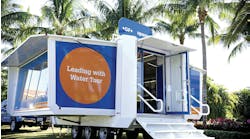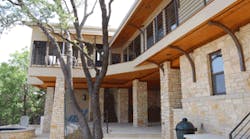Latest from Plumbing
Sponsored
AUSTIN, TEXAS — The owners of the home overlooking Lake Travis in the Austin suburb of Lago Vista had decided to renovate. An older couple, they wanted the space to entertain visiting friends and family: a deck, guest rooms, extra bathrooms — the works.
They contacted builder-remodeler Matt Risinger of Risinger Homes to transform their single-story structure. Over the course of the $500,000 project, Risinger expanded the interior by 900-sq. ft., creating more living space on the lower level with a master bedroom and studio space above. He also built 1,500-sq. ft. of outdoor living space, including a swimming pool and patio complete with an outdoor kitchen and fireplace.
To install the new bathrooms and make sure they had enough hot water to satisfy the owners and their prospective guests, Risinger turned to Dennis Guthrie of Custom Plumbing in Austin.
Custom Plumbing is a third-generation, full-service shop started in 1969. They boast the entire state of Texas as their service area. Custom Plumbing has worked to make green and sustainable systems a part of their business model, and now offer their customers low-flow faucets and fixtures, graywater reclamation systems, rainwater collection systems and tankless water heater installations.
But the Lago Vista home offered Custom Plumbing a chance to do something new: install a heat-pump water heater.
Risinger had talked with the owners about how they wanted to address the hot-water demands of their remodeled home. At first the couple looked at solar systems, but dropped the idea when they saw the high front-end cost. Rather that default back to a conventional tank product, Risinger sold them on a Rheem HP-50, a hybrid heater that combines an air-source heat pump with conventional electric technology as a back-up.
“A lot of our baby boomer customers couldn’t care less about the virtues of green construction, but they realize that, at some point, they will be living solely off their assets,” Risinger says. “Utility bills will command a substantial and growing portion of their monthly overheads.”
According to Danny O’Neal, Custom Plumbing’s technician for the job, the installation went smoothly. Key considerations were the extra weight of the HP-50 (200-lbs. versus approximately 125-lbs.) and the added height (at least 18-in. taller at 75-1/2 inches).
“That extra height and weight makes the location of the heater an important consideration,” O’Neal said.
The unit’s integral heat pump is fully charged and sealed, like a refrigerator or a room air conditioning unit, so an HVAC technician is not required. The unit installs much like a standard electric water heater, except that the hot- and cold-water connections are situated on the side of the unit, not the top.
Because it’s drawing heat out of the surrounding atmosphere, the heat-pump needs about 1,000 cubic feet of space around it to give it the necessary amount of makeup air. Custom Plumbing installed the unit in a crawl space with a 10-ft. high ceiling that gave it plenty of room.
A final consideration is a condensate drain line. As the pump removes heat from the surrounding air it dehumidifies as well. The resulting moisture has to go someplace. “Because we installed the HP-50 adjacent to sewage pump in the crawl space,” Risinger said, “it was a simple matter of running the condensate line right into it, rather than into a distant drain.”
In all, the entire installation took about four hours. Custom Plumbing also installed a back-up 40-gal. standard electric heater, just for use on days when the extended family is paying a visit. The low-boy was installed in a closet on a stairway landing in the crawlspace, with just a few feet of pipe connecting it to the heat pump water heater positioned just outside the closet – there was not enough room inside the closet to put the two heaters side-by-side.
Each unit is equipped with its own flip switch, located in an upstairs living area. It makes it simple for the homeowners to switch off the smaller unit when the extra family or guests leave.
The switch to a heat-pump water heater is expected to save the household at least $250 annually, for a savings of $2,500 before the end of the 10-year warranty period — more than enough to pay for the original outlay, while guaranteeing years of savings down the road.


